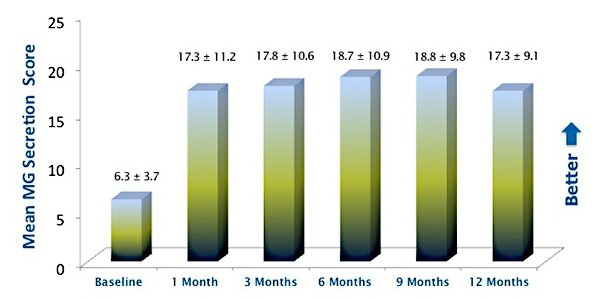2 juillet 2015
Meibography is the first and only definitive test for any form of dry eye.
Meibomian Gland Dysfunction | Treatment | TearScience
TearScience® is the only company dedicated to identifying, diagnosing, and treating MGD, the leading cause of dry eye, with an FDA-cleared solution that restores gland function.
http://tearscience.com
TearScience® is the only company dedicated to identifying, diagnosing, and treating MGD, the leading cause of dry eye, with an FDA-cleared solution that restores gland function.
http://tearscience.com
| Eric Donnenfeld, MD, Ophthalmic Consultants of Long Island, Rockville Centre, NY |
| Meibography is the first and only definitive test for any form of dry eye. |
|
|
| During the past 5 years there has been a sea change in our understanding of dry eye. Where we had once thought that aqueous deficiency was the root cause of most dry eye symptoms, we now know that the primary culprit is meibomian gland dysfunction (MGD). In a landmark study, Michael Lemp and coworkers found that MGD was involved in 86% of the dry eye cases surveyed.1 For most patients, dry eye disease is MGD. |
| This raises an interesting question: If dry eye is so disproportionately a meibomian gland issue, why didn’t we recognize that fact sooner? In part, this stems from the difficulty of dry eye diagnosis and the absence of a definitive diagnostic test. Among medical specialties, ophthalmology and optometry have relatively few lab tests—instead, we have traditionally made diagnoses based on seeing the disease. We see cataracts, we see corneal dystrophies, we see optic neuropathy, and we see retinal disease. But the closest we could come to seeing MGD was to look for lid margin signs and perform meibomian gland expression, and few doctors took the time for either. So MGD remained hidden. We could see the effects of MGD but not the disease. We had signs but not certainty. |
| Until now. Today, with LipiView® II Dynamic Meibomian Imaging, we can see and even quantify MGD. We can tell instantly whether the patient has MGD, and we can distinguish mild early disease from moderate and late stage disease. |
| Meibography cuts through the notorious fog of dry eye diagnosis. Traditional dry eye test results are often contradictory, and signs are frequently disproportionate to symptoms. Even after testing, doctors often remained uncertain about whether a patient had dry eye, and, if so, was it caused by aqueous deficiency or MGD? That uncertainty made some doctors tentative about recommending LipiFlow®thermal pulsation. With meibography, all that changed. Meibography is the first and only definitive test for any form of dry eye—looking at the results of Dynamic Meibomian Imaging, both doctor and patient can know without question that the disease is present. As with other chronic progressive diseases, structure and function do not correlate 100%. Thus, to obtain a full assessment of meibomian gland health, even when there is no sign of structural compromise, we should also evaluate meibomian gland function, using the MGE. |
| When we as doctors see tortuous, shortened, or missing glands, we know that LipiFlow® treatment is indicated and almost certainly will be beneficial—and we know that it is better to treat sooner rather than later.2 Similarly, patients can be shown their meibography image, along with images of healthy glands and late stage MGD. Knowing where they are on the slope toward significant disease allows them to understand the importance of treatment. Doctors and patients can be on the same page. |
| We no longer have to wait for our patients to tell us there is a problem. We have the technology to detect meibomian gland disease and offer early intervention. It’s a new day in dry eye diagnosis. |
| REFERENCES |
|
| Don’t Wait to Perform LipiFlow® |
| PROSPECTIVE STUDY FINDS EARLY LIPIFLOW TREATMENT MORE EFFECTIVE1 |
| In a prospective, multicenter clinical trial, 99 meibomian gland dysfunction (MGD) patients (197 eyes) received a single, 12-minute LipiFlow® treatment. Patients all had meibomian gland secretion scores ≤ 12 and dry eye symptoms (Ocular Surface Disease Index symptom scores ≥ 13). Secretion characteristics were assessed for 15 glands in the lower eyelid using the Meibomian Gland Evaluator and scored from 0 (no secretion) to 3 (clear oil). Results can be seen in the graph below. |
Publicité
Publicité
Commentaires





/http%3A%2F%2Fstorage.canalblog.com%2F56%2F72%2F1309572%2F106274822_o.jpg)
/http%3A%2F%2Fstorage.canalblog.com%2F86%2F42%2F1309572%2F105112561_o.png)
/http%3A%2F%2Fstorage.canalblog.com%2F09%2F20%2F1309572%2F104160944_o.jpg)
/http%3A%2F%2Fstorage.canalblog.com%2F77%2F94%2F1309572%2F103224111_o.png)